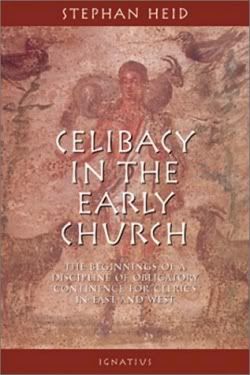 Celibacy in the Early Church: The Beginnings of Obligatory Continence for Clerics in East and West
Celibacy in the Early Church: The Beginnings of Obligatory Continence for Clerics in East and WestStefan Heid
Ignatius Preess (April 2001)
Orginal edition
Zolibat in der fruhen Kirche: Die Anfange einer Enthaltsamkeitspflicht fur Kleriker in Ost und West
Schoningh (1997)
Translator Michael J Miller
Fr. Stephen Heid of the Pontifical Institute of Sacred Archeology presents a detailed history of the clerical discipline regarding marriage and celibacy of the higher clergy from the time of the Apostles to the Seventh Century. He starts out by changing the question from "could priests be married” to “what was the discipline of the early Church.” . Christian Cochini (Apostolic Origins of Priestly Celibacy) postulated that total sexual continence of the higher clergy was the norm in the early Church . That is Deacons, Priests, and Bishops totally abstained from sexual relations, even with their lawful wife (the willing permission of ones wife was required for ordination.) Heid tests this theory and the opposing theories that the higher clergy had no more serious discipline than the chastity expected of any Christian couple, or at the most practiced Liturgical Continence i.e. on days when they celebrated the liturgy, against the record of the Church. With some minor quibbles he finds the evidence supports Cochini.
Scripture describes the Church as The Bride of Christ. The clergy when leading the Church in worship are understood to be acting for Christ. In analogy they are married to the Church. For a priest to get married is in the analogy the equivalent of adultery. With this understanding Heid describes the discipline as of the Early Church follows:
- Celibacy was the ideal, but to prevent a shortage of clergy married men could be ordained.
- To be ordained the candidate must “be the husband of one wife” 1 Timothy 3:1-7) That is unmarried or only married one once.
- Once ordained he could not marry.
- Married clergy were continent, that is abstained from marital relations with their wife.
- The cleric was still married, and was expected to live with his wife and provide for her support.
The practice was apparently the universal norm universal across the church, though he points out that in some out of the way areas their may have only been ritual continence. This and other break downs of church discipline was the often the case during persecutions or in areas disrupted by heretical movements. In the West the practice gradually shifted to celibacy for all higher clergy which became the norm long before the medieval decrees on the subject, which were calling wayward clergy back to the customary norm not imposing a new requirement. The East followed the same practice until the Council of Trullo which ruled that Bishops had to be celibate and if married he could no longer live with his wife though he still had to provide for her support. Married priests and deacons were to only practice ritual continence. This practice is still in effect in Orthodox and Eastern Catholic Churches, and by exception in the Latin Rite .
Fr. Heid explains this was not quite as counter cultural then as it would be today.
- Ritual continence and fasting before leading worship was the requirement in the Old Testament and the norm in most religions. This is not a statement that sexual relation or food are bad but rather a total dedication to preparing for the higher calling of leading worship.
- The ancients had a higher opinion of human ability to control sexual desires than is common today.
- continence for various other reasons was a not to common but socially acceptable practice, of which there are several documented instances.
Ordination was usually a “second career.” People married in their teens, candidates would not be ordained until their children were out of the house. it was realized this is not a discipline for hormone crazed teenagers. This also insured that those ordained, married or not, were mature with a long track record of responsible behavior.
Enforcement was passive. That the couple was following the practice was assumed, only if there was flagrant conduct or the wife became pregnant would any action be taken. Usually limited to removal from office though they remained in good standing in the Church .
Total continence requires two to not tango. Women who lived in the Early Chruch community probably shared the ideal of priestly continuance even if they did not want their husband to participate. Fr. Heid proposes several practical reasons why a wife might agree to their mutual continence.
- Time needed to serve effectively in clerical office would leave the wife with a larger role in the management of her household.
- Being the wife of a member of the clergy brought position and prestige in the community
- The death rate for women in childbirth was much higher then than now and late pregnancies had still a higher rate. On average this would increase her life expectancy.
Rome Reports has this video of a recent conference on priestly celibacy with Fr Hieid as one of their interviewees‘.
Analysis
Much comment on the subject has been colored by a legend reported as fact by the usually reliable Church historian Socrates (d. before 439.) One Paphnutius, allegedly a monk and bishop from Egypt at the Council of Nicaea in 325 is said to have intervened against a proposal for complete continence by recommending continuing the existing pratice of not having a Church wide policy, even though he was celibate. The proposal was allegedly voted down on his recommendation. In 1968 was demonstrated that Socrates was the victim of a hoax. Paphnutius, if he existed ,was a monk in Egypt probably not a bishop and he did not attend the Council of Nicaea. While the every detail of the Council was commented on by somebody or other starting with the closing gavel, there was no reference to this intervention by Paphnutius until Socrates reports it one hundred years later. It is inconsitent with what the Council did approve, and there are other major problems. This mistaken report caused people to assume there was no point in researching the topic. With the realization that this was not the case, scholars started to reexamine the data.
From the fourth century there are a number of references to total clerical continence as a requirement. These are often in decrees of local councils on rather mundane matters restating and/or clarifying long time practices of the church. The basis for continence was the cited as the long established practice of the Church from the time of the Apostles. There is no evidence that these decrees were challenged as innovations. The context would suggest that the authors of those councils did not consider continence rules to be a new innovation.
In the First to the third centuries the evidence is less clear. The authors are not as specific but their comments on related subjects make much more sense if total continence is the assumed background for their comments.
Biblically the early authors cited the Pastoral epistles especially, using them as stating the requirements for ordination. The repeated requirement of “the husband of one wife” (1 Timothy 3:2, 3:12, Titus 1:6) and “the wife of one husband” (1 Timothy 5:9) was seen as formulaic statement for some one who is never married or married once and is still married or never remarried. Paul’s various comments on marriage and ministers makes good sense in this case. They also would site Jesus’s comment about those who are “eunuchs for the sake of the Kingdom” (Mathew 19:12) as referring to continent clergy. While these and the other scrpture cited are certainly capable of other meanings, this interpretation a makes a consitant expalnation of much contested verses and makes good sense with the history and pratice of the Church, which accepted these writtings as cannoical. In the Eastern authors it is the understanding of people who spoke biblical Greek as their first language.
Overall Fr. Heid eliminates any possibility that that celibacy was an imposed practice or that the discipline expected of the upper clergy was no different than that of married lay couples, rather the discilpine grew out the the belief and partice of the Apostalic Chuch. He presents a strong case for a total continence discipline for the upper clergy as the universal norm and in general practice. The evidendce is short of a 100% lock for the biblical support and the first centuries, and I think his discussion leaves open possibility there was a less comprehensive "back county" discipline that eventually came to fore in the Council of Trullo. But still a strong and compelling argument.
The modern calls for a change in discipline, even if they have merits for other reasons, cannot be supported by the belief and pratice of he early Church.
Though it is a well footnoted scholarly work that, of necessity, sometimes spends space on technical items of translation and context, the main text is very readable and accessible to a general reading audience. If you are interested in the subject it is highly recommended.
=====================
While we are sort of on the subject why not.

No comments:
Post a Comment